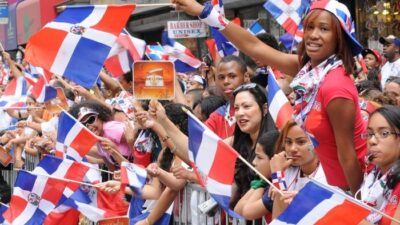Where is the Dominican Republic?
The Dominican Republic is a country in the West Indies that occupies the eastern two-thirds of Hispaniola, the second-largest island of the Greater Antilles chain in the Caribbean Sea. Haiti, also an independent republic, occupies the western third of the island.
The capital of the Dominican Rebublic is Santo Domingo. It is the largest Caribbean city.
What are the people of the Dominican Republic like?
The population of the Dominican Republic is predominantly of mixed African and European ethnicity, and there are small Black and white minorities. Some scholars believe that very few people are descended, even indirectly, from the indigenous Taino peoples, who were mostly cut down by disease, warfare, and the effects of forced labour shortly after their first contact with Europeans.
The Spanish language has always been predominant, although English is becoming more common because of continued emigration to the United States. Haitian immigrants speak French Creole.
Dominican food is a vibrant mix of cultures. The varying influences throughout its history and the distinct groups of people who have inhabited the island mean Dominican recipes are unique to the island.
Sancocho is the national dish of the Dominican people. It is a soup made with a variety of meats and vegetables such as pork, beef, goat, fish, sweet potatoes.
One of the traditional foods served for breakfast is Mangú, which comprises mashed plantains with some flavouring added and topped with lots of red onions. Fried cheese is also a favourite served with fried salami and eggs.
When was the Dominican Rebuplic colonised?
In December 1492, European navigator Christopher Columbus sighted the island and called it La Isla Española “The Spanish Island”, later Anglicised as Hispaniola.
In 1496 Spaniards set up the first Spanish colony in the Western hemisphere at Santo Domingo, which subsequently serves as the capital of all Spanish colonies in America. The Taino who were established on the island resisted Spanish incursions, but it did not take long for their numbers to be reduced through disease and the effects of forced labour.
Following the Nine Years’ War between France, and the Grand Alliance, which included England, Spain, the Dutch Republic and Austria, the 1967 Peace Treaty of Ryswick gave the western part of Hispaniola island (Haiti) to France and the eastern part (Santo Domingo – the present Dominican Republic) to Spain.
Fight for Independence
In 1795 Spain ceded its share of Hispaniola island to France. Then in 1808, Spain retook Santo Domingo following a revolt by Spanish Creoles. Heavily influenced and encouraged by Haiti, which had achieved independence in 1804, Dominicans declared independence as the Republic of Spanish Haiti in 1821.
In 1822, Haitian President Jean-Pierre Boyer marched his troops into Santo Domingo and annexed it. Now under Haitian rule, for 22 years the entire island of Hispaniola was known as Haiti.
Though Haiti had been only the second European colony in the Americas to achieve independence, and its revolution made up one of the largest and most important slave revolts in all of history, the smaller Dominican population suffered under Haitian rule. Though the two were supposedly united, the western half of the island was clearly where the political influence lay, and the crippling debts imposed on Haiti by the French and other powers had a profoundly negative effect on the island’s economy.
In 1838, three Dominicans named Ramón Matías Mella, Juan Pablo Duarte and Francisco del Rosario Sánchez founded a resistance organisation. The resistance set about gathering support from the Dominican population, even covertly converting two regiments of the Haitian army.
On 27 February 1844, the resistance leaders launched the Dominican War for Independence, eventually winning the war and founding the Dominican Republic on 28 February 1844.
Corrupt government
In 1846 President Ramón Buenaventura Báez Méndez, better known as Buenaventura Báez went to Europe to convince France to establish a protectorate over the Dominican Republic, but the French refused. He then attempted to convince the United States to take over the country. Baez continually prevented the growth of democracy and sold out the country to foreign and commercial interests. He was president again from 1856 until 1857 when he was deposed in a coup.
Báez next supported the idea of Spain taking over the Dominican Republic. He went into exile in Spain and led a luxurious life there. The Spanish agreed to occupy the Dominican Republic in 1861.
Tired of being a colony, the Dominican Republic sought Independence once again. In 1863, the Dominican Restoration War began. The war resulted in the restoration of Dominican sovereignty, the withdrawal of Spanish forces, and the establishment of a second republic in the Dominican Republic. The island gained its independence from Spain on 27 February 1865.
Báez returned to the Island to begin a third presidential term, but another coup removed him in May 1866. In 1868 they again made him president. This time he was determined to gain annexation by the United States. He even persuaded the United States to send warships, ostensibly to protect his country from Haiti; in reality, he sought to protect his own business interests. The United States removed the warships shortly after, and in 1874 Báez again was forced to give up the presidency. He served his last term in 1876–78 and was then exiled permanently to Puerto Rico.
The country today
Corrupt governments, dictatorships and civil unrest have plagued the Dominican Republic. Between 1965-66 the United States, fearing the installation of a communist regime occupied the country.
A hurricane devastated the country in 1979, and the faltering economy produced inflation, strikes, and depressed conditions. The country felt the earthquake that devastated Haiti in 2010, but it didn’t suffer as much damage as its neighbour.
The Dominican Republic has a mixed economy based mostly on services, including tourism and finance, trade, manufacturing, telecommunications, construction and agriculture.
About three-fifths of Dominicans remain below the poverty level, despite improvements in the national economy, and the vast majority of the population belongs to the lower-income segment, including most farmers, landless agricultural workers and unskilled manual labourers. However, the middle class has grown markedly since the mid-20th century.
There is a history of racism in the country spurred by the uneasy history with Haiti. After independence, the Spanish-speaking Dominicans worked to eliminate Haitian (and by extension African) cultural influences. Although the elite may have been able to cling to their Spanish ancestry, the blood of Africans runs through the majority of the mixed population.





